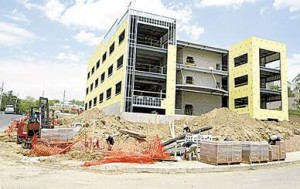 Kiryas Joel, NY – Even the music at Yonah Dresner’s restaurant/cafe is different. “It’s called ‘shira,’ which means to sing,” the owner says of the a cappella music, specially recorded for the seven weeks after Passover when instrumental music is banned. The vocal music sounds through the speakers as gender-separated tables of men with curly side locks and women in wigs study menus that include pizza, blintzes and baked salmon.
Kiryas Joel, NY – Even the music at Yonah Dresner’s restaurant/cafe is different. “It’s called ‘shira,’ which means to sing,” the owner says of the a cappella music, specially recorded for the seven weeks after Passover when instrumental music is banned. The vocal music sounds through the speakers as gender-separated tables of men with curly side locks and women in wigs study menus that include pizza, blintzes and baked salmon.
Subscribe to our Daily Roundup Email
“It’s a modern thing,” Dresner says. A 22-year resident, Dresner commuted for 15 years to Manhattan’s Diamond District to support a family that grew to include nine children. Sensing opportunity in the explosive changes of his community, he worked part-time for a year in cafes in Williamsburg to do “research” for his venture.
His restaurant in the new business center on Bakertown Road is one of two restaurant/cafes that have sprung up within the past year, and one of only three in the whole village, adding new life to the dining out experience.
The businesses mark another step in the ever-growing expansion of goods and services within the community.
Take a drive through the 1-square-mile Hasidic community these days, and you’ll notice a new look and feel to the place. It’s not just Dresdner’s trendy new restaurant, the gleaming new business center it is located in or the myriad of new buildings and condominiums going up on every hillside and new cul-de-sac.
It’s in the confident zip of the men in black coats and fedoras as they rush from synagogue to offices and to construction sites, in the smart fashions of the women in dark berets and trench coats headed to new village office jobs, and in the talk of officials like Gedalye Szegedin, the village administrator who speaks of the community’s evolution.
It seems that the deeply religious community of 20,000-plus has always had a grander vision of itself than just a small country outpost of Hasidic orthodoxy.
To sustain a community where couples are encouraged to marry young, and six to eight children per household is the norm, the village has had to create more jobs, more services and more social opportunities, Szegedin says.
To thrive, the 31-year-old village had to become more like a city. And that means looking like one.
It’s what Szegedin calls the “window dressing” phase of his community’s aggressive push toward greater self-sufficiency. The more substantive changes, he emphasizes, started just over five years ago, when the village created its first fire, garbage and public safety departments, as well as expanded its water and sewer infrastructure.
That provided the foundation for more growth, which resulted in more construction and more jobs, he says.
An entire cottage industry of subcontractors, including concrete companies, fire sprinkler system installers, even landscapers, has sprung up thanks to the growth, providing 70 percent of all the blue-collar work in the village, Szegedin says.
ot everyone appreciates the village’s new look. The towns neighboring Kiryas Joel claim the village’s aggressive development has been at the expense of their communities.
Residents within the towns of Blooming Grove and Woodbury both formed villages as bulwarks against the Hasidic village’s expansion. The village has been locked in legal battles over infrastructure improvements, including a proposed pipeline to tap New York City’s Catskill Aqueduct as well as over increased sewage treatment capacity for its neighbors.
By Szegedin’s own estimates, 60 percent of his rapidly growing community is eligible for welfare. Many of the latest building projects, including the renovation of the old shopping center and the construction of the new women’s center, were possible only with the help of generous government grants.
“I see nothing wrong in making buildings more attractive,” says Assemblywoman Nancy Calhoun, R-Blooming Grove, a frequent Kiryas Joel critic. “But”¦ I think you’re going to find that a lot of those projects are being funded by other people.
“I’d love to have my house brought up to speed myself and have somebody else pay for it.”

very positive
By Szegedin’s own estimates, 60 percent of his rapidly growing community is eligible for welfare!!!!
Gee, how positive is that?
1103 very positive!
Extremely positive. Other NY areas are more like 80-90% Welfare eligible
Tell Nancy Calhoun the politician that if she wants her house brought up to speed and somebody else pay for it, it can be arranged. Meet the KJ officials and take care of the village needs and it all can be arranged – legally!
i have been living here for over 30 years when it was a forest..B”H i am still here to see this major growth and i just pray i should see it in 30 years from today..I myself added over 29 members to this community,and 6 on the way..I get along with my blooming grove and neighboring friends..Happy shevoath to all
a welfare state, oh, i mean village.
eppes, maybe I can get in on the action.
Are we working (MR. Szegeddin) towards a goal of reducing Welfare elegibility/dependency???!!!
wigs and fedoras??? Satmars don’t wear Fedoras, only snags and Chabad do. What about the women? I thought they wore tichels.